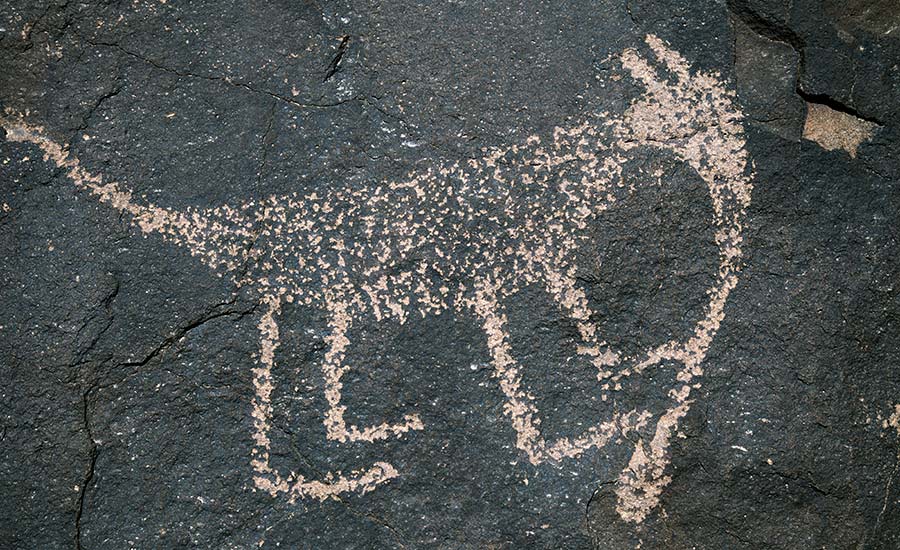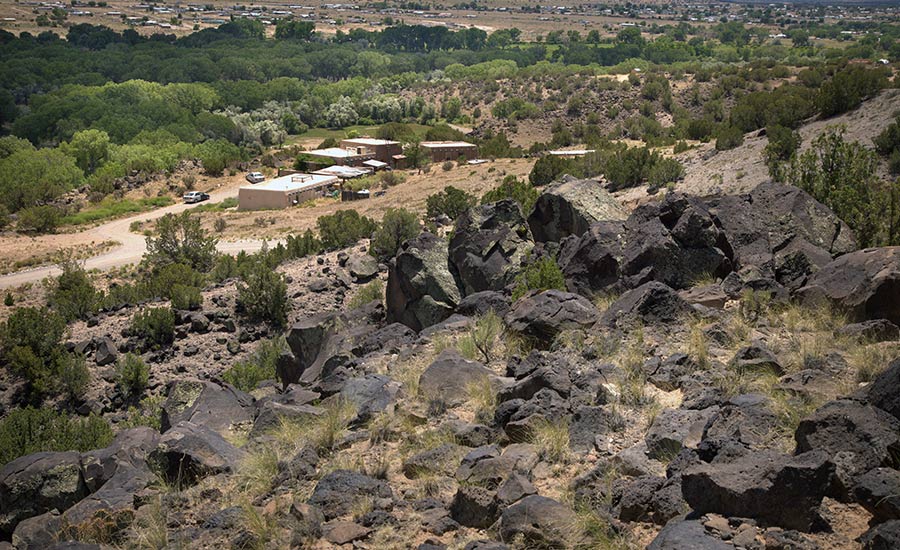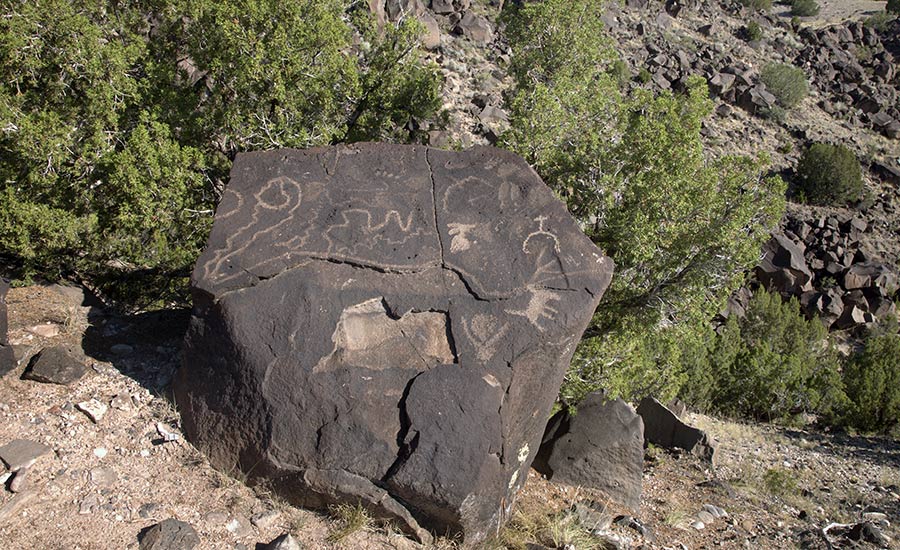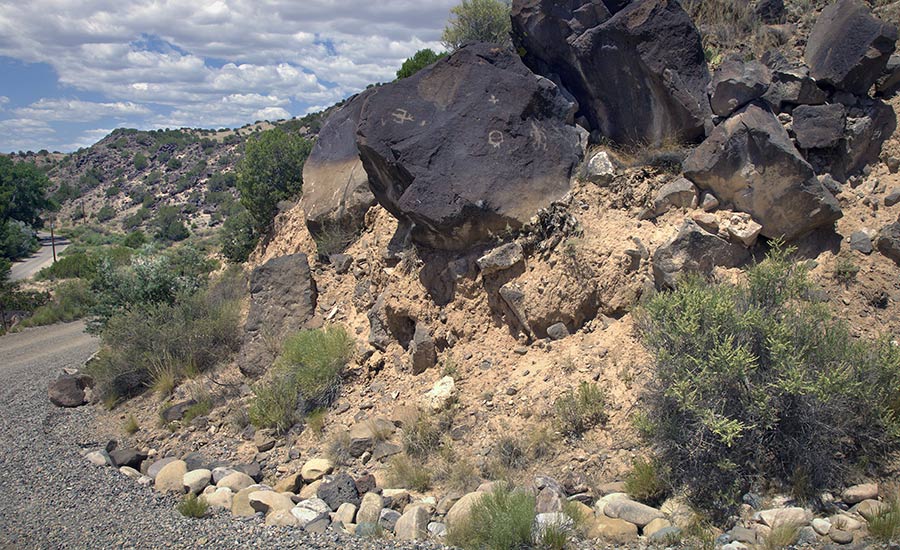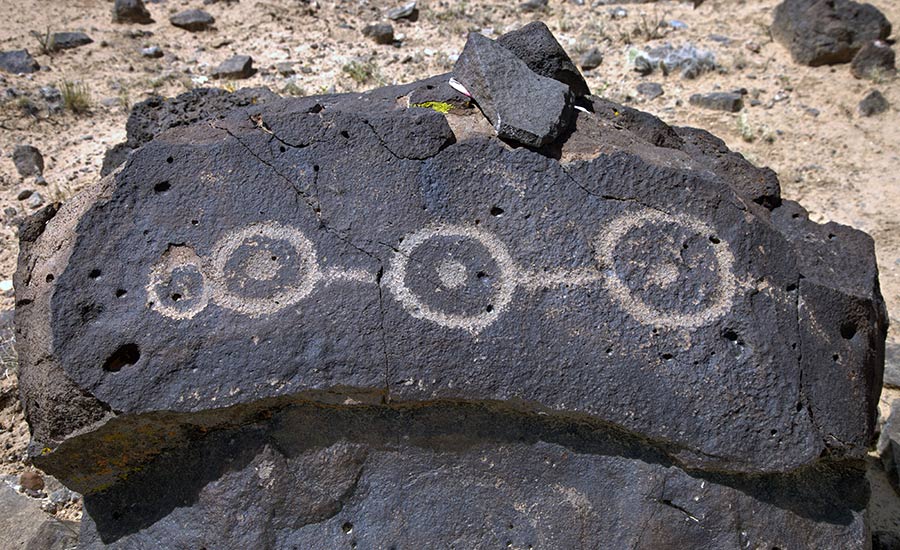“Ancient pueblo sites are our treasure to honor, celebrate and protect. These sites remind us of the lives of the earlier people who lived on the land. The places they chose to live give us insights into their own unique sense of aesthetics. The evidence of their intimate knowledge of seasonal cycles, astronomy, belief systems provides an example about how to live with respect on the land. ”
History
Petroglyphs, forms of rock art in which images and/or symbols are carved or otherwise marked on rock, can be found in Africa, the Americas, Asia, Australia, and Europe. The world’s oldest known petroglyphs date back as far as 40,000 years ago. In North America, the earliest discovered petroglyphs were created from 10,000 to 15,000 years ago, in locations from Massachusetts to California. Unique among them is the Wells Petroglyph Preserve, a collection of between 8,000 and 10,000 images – including representations of humans and animals – in northern New Mexico’s 36-square-mile Mesa Prieta, a section of the state estimated to contain nearly 70,000 individual petroglyphs, and 5,000 archaeological features, among them rock walls, fields, and terraces. The area abuts northern stretches of the Rio Grande and is set along the El Camino Real de Tierra Adentro National Historic Trail. The landscape, near the first Spanish capital in the Southwest at San Gabriel de Yunque Ouinge, is rugged, volcanic and sedimentary terrain supporting grasses, juniper and piñon pine. The 156-acre Preserve, which holds the most concentrated area of petroglyphs on Mesa Prieta is listed in the New Mexico State Register of Cultural Properties – Mesa Prieta, which includes Wells and is the state’s largest petroglyph preserve, is listed in the National Register of Historic Places.
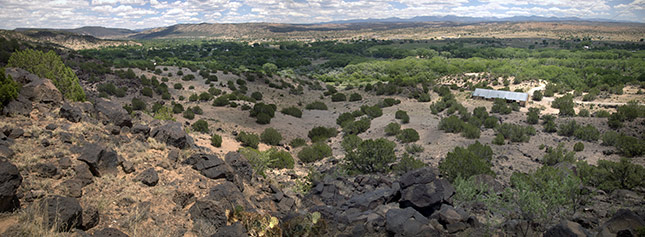
Photo © Richard Fenker
The Wells Preserve’s earliest images, created during the Archaic period (5500 B.C. to 800 A.D.), represent some 5-10% of the images and were inscribed by big game hunters and gatherers thousands of years ago. These etchings include non-representational patterns, such as six-pointed stars, and one-pole ladders, which some scholars, such as ethnobiologist Dr. Richard Ford, have proposed may have had ceremonial purposes.
Petroglyphs created during the Ancestral Puebloan period (A.D. 800 to 1598) represent nearly 80% of the images, with depictions of hunting and ceremonial activities, many of which are still in practice; solar calendar glyphs; and a series of fifteen animal flute players thought to be unique in the world (one appears to be a rat, another an ant and another an armadillo, while some seem to be fantastical unidentifiable animals).
Images from the Historic Tewa Pueblo period (A.D. 1598 to the mid-1900s) and the Hispano period (A.D. 1700 to the mid-1900s) include horses with riders, lions, carts, Catholic motifs, cattle, churches, initials, and dates. Many of those who came with Juan de Oñate, who established colonial New Mexico for Spain in 1598, were escaping the Inquisition and the images they created depicting Spanish culture on the Preserve and the Mesa are a unique representation of the cultural life of generations of local Hispano settlers and sheepherders. Moreover, there are images that appear to relate to the Pueblo Revolt of 1680, during which Ohkay Owingeh native Po'pay organized an uprising among the Pueblo tribes, and drove Spanish priests and adventurers back to El Paso, Texas (a carved stone statue of Po'pay is in the Statuary Hall of the U.S. Capitol in Washington, D.C.).
Some relatively recent petroglyphs date from the first half of the twentieth century, during President Franklin D. Roosevelt's Works Progress Administration (WPA) when Great Depression-era Civilian Conservation Corps (CCC) and WPA employees were active in the area. Images include livestock brands, names, dates, peace signs, graffiti, and WPA symbols.
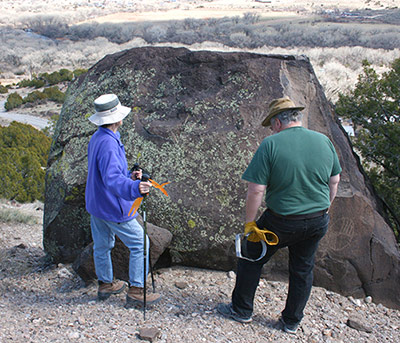
Katherine Wells and Museum of New Mexico Chief Conservator Mark MacKenzie
examine lichen encroachment on a petroglyph in the Preserve, photo courtesy
Mesa Prieta Petroglyph Project
In 1992, Katherine Wells, a multimedia artist and author, acquired the land on which the Preserve sits; according to Wells: “I was already a petroglyph junkie when I arrived in New Mexico from California and knew that there were some petroglyphs on the land I purchased, but I had no idea of the concentration there was until I started wandering around on the land.” In 2007, Wells donated the Preserve to the Archaeological Conservancy, a non-profit organization dedicated to acquiring and preserving archaeological heritage on private lands. It is now managed by the Mesa Prieta Petroglyph Project, a 501(c)(3) non-profit created in 1999, whose mission it is to preserve and protect all archaeological features on the Mesa. Volunteers with the Project run school programming and tours on the Preserve, train docents, and maintain tour trails. Some 600 adults and children visit the Preserve every year.
The importance of the site was noted in a 2012 letter by Dr. Kurt Anschuetz, Program Director of the Rio Grande Foundation for Communities and Cultural Landscapes in Santa Fe, New Mexico, to Thomas Romero, Executive Director of the Northern Rio Grande National Heritage Area: “Based on my work both as an archaeologist and a cultural anthropologist for three decades in the Land of Enchantment [New Mexico], and having served as the Program Director of the Rio Grande Foundation for Communities and Cultural Landscapes for more than ten years (1998-2010), I find that Mesa Prieta stands among Bandelier National Monument, the Valles Caldera, Mount Taylor, the Albuquerque West Mesa, and the Zuni Salt Lake as one of the most meaningful and culturally sensitive landscapes in the State of New Mexico. This special landscape deserves our consideration and care.”
Threat
Over the years the petroglyphs of the Wells Preserve have faced many threats. There have been incidents of vandalism, although the site’s isolation – off the main highways and surrounded by private land on three sides – affords it some protection. In addition, the area was popular for sheep grazing in the 1950s. There has also been considerable mining on the Mesa, which continues today although Vecinos del Rio, a local grassroots environmental organization, eventually prevented mining trucks from passing through the Wells Preserve. Currently, the most significant threat is from erosion. New Mexico, with other states in the Southwest, is experiencing a severe multi-year drought. When periodic heavy rains do occur, it can result in rock falls, flooding, crumbling of soft sediment and serious vertical erosion in arroyos and drainages. Several important petroglyphs are in imminent danger of displacement, including some solar calendar marker rocks, which will no longer function as they were intended if their alignment is altered to change the shadows they cast.
In addition, a two-lane county road passes along one side of the Preserve, and at one point through the Preserve itself. This road used to be the bed of a narrow gauge railroad, and at one point several cuts were made in the roadway in order to reduce the severity of the curves. These cuts have seriously eroded and rocks fall down onto the road during rainstorms. The falls threaten the stability of very large boulders above, many of which feature important petroglyphs. Other stretches of similar erosion exist along a separate private gravel road passing through the Preserve and on up to the mesa top.
The Mesa Prieta Petroglyph Project has enacted several programs to help protect the site: one monitors natural and human caused damage to petroglyph sand terrain; and another works to remediate serious, damaging erosion that is endangering many of the petroglyphs. Unfortunately, the organization has struggled to keep up with recent damage.
1 Tessie Naranjo, Letter describing the work of the Mesa Prieta Petroglyph Project in support of a grant application to the Northern Rio Grande National Heritage Area, January 11, 2011.

